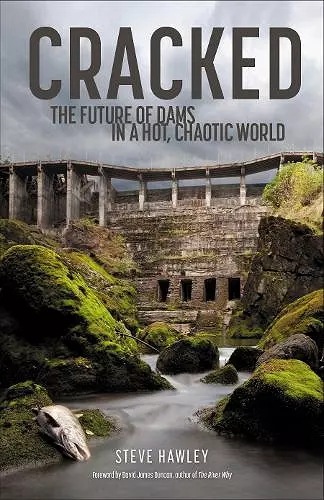Cracked
The Future of Dams in a Hot, Crazy World
Format:Hardback
Publisher:Patagonia Books
Published:15th Jun '23
Should be back in stock very soon

The ugly truth about dams is about to be revealed.
During the first two decades of the twenty-first century, the whole messy truth about the legacy of last century’s big dam building binge has come to light. What started out as an arguably good government project has drifted oceans away from that original virtuous intent. Governments plugged the nation’s rivers in a misguided attempt to turn them into revenue streams. Water control projects’ main legacy will be one of needless ecological destruction, fostering a host of unnecessary injustices.
The estimated 800,000 dams in the world can’t be blamed for destroying the earth’s entire biological inheritance, but they play an outsized role in that destruction. Cracked: The Future of Dams in a Hot, Crazy World is a kind of speed date with the history of water control -- its dams, diversions and canals, and just as importantly, the politics and power that evolved with them. Examples from the American West reveal that the costs of building and maintaining a sprawling water storage and delivery complex in an arid world—growing increasingly arid under the ravages of climate chaos—is well beyond the benefits furnished. Success stories from Patagonia and the Blue Heart of Europe point to a possible future where rivers run free and the earth restores itself.
“Both troubling and encouraging, a well-told tale of environmental activism and citizen action.”—Kirkus Reviews about Recovering a Lost River
"Hawley’s thorough research makes a damning case for rethinking how to source water, and anecdotes about ecosystems that have flourished after dam removals strike an optimistic note about the road ahead. Environmentalists will be riveted." -- Publisher's Weekly
Dams are ineffective and an ecological and humanitarian hazard, contends journalist Hawley (Recovering a Lost River) in this impassioned exposé. He surveys the environmental damage caused by dams alongside stories of people displaced and ill-served by their construction. Explaining how dams destabilize ecosystems, he tells how putting up dams in the Westlands Water District near Fresno, Calif., in the 1960s disoriented migrating salmon by disrupting river currents and poisoned bird populations after poor irrigation led to the buildup of toxic chemicals. Hawley argues that the purported benefits of hydroelectric dams—green energy production and a steady water supply—are largely myths; the decomposition of organic flotsam that builds up in reservoirs produces methane at rates that can rival fossil fuel production, and as the globe heats up, evaporation will take an increasingly large cut of reservoir water. Highlighting the heartbreaking humanitarian consequences of dam construction, the author describes how the Bureau of Reclamation forced the Mandan, Hidatsa, and Arikara tribes off their ancestral land in North Dakota for a pittance of the tract’s value, destroying their way of life. Hawley’s thorough research makes a damning case for rethinking how to source water, and anecdotes about ecosystems that have flourished after dam removals strike an optimistic note about the road ahead. Environmentalists will be riveted. -- Publisher's Weekly
"Lavishly displayed color photographs help illustrate Hawley’s narrative, which might motivate a nationwide rethinking of these extravagantly expensive, outdated systems." — Alan Moores, Booklist Starred Review
"Environmental journalist Hawley, whose Recovering a Lost River (2012) likely helped spur legislative action to remove four federal dams to resuscitate one of the great salmon rivers of the world, the Snake, here uses a wider lens to examine the dubious value of many of the other dams built worldwide in the last century. According to the author, those dams have decimated fish populations, undermined fragile ecosystems, inundated sacred grounds, created a massive methane footprint, cost outrageous public sums to build and maintain for the actual value they provide to farmers and the electrical grid, and threatened public safety—some 15,600 “highhazard” dams in the U.S. would cause significant loss of life if any failed. These dams have also lost more water to evaporation than they’ve provided to the cities they were intended to serve. Hawley does an excellent job of laying out the history of dam building, especially in the arid American West; its failings; some recent successes in reopening rivers (the Elwah, for example); the mechanics—and grass-roots politicking—of dam removal; and viable alternatives to dams, like underground storage of water and solar power. Lavishly displayed color photographs help illustrate Hawley’s narrative, which might motivate a nationwide rethinking of these extravagantly expensive, outdated systems." — Alan Moores, Booklist Starred Review
"It’s not a light read, but it’s an important one." -- The Drake
In compelling detail and persuasive argument, Steven Hawley makes a case for the immeasurable environmental, economic, and social damage wrought by the damming of American waterways. Sold to an unwary public as a panacea, industrial dams have, according to Hawley’s eloquent reporting, proved themselves in many cases to be exactly the opposite — stunningly destructive, wasteful, and, in the end, beneficial to only a very few wealthy people and corporations. Hawley’s message is driven home with page after page of vibrant and chilling photography that makes this book as beautiful as it is impelling. -- Big Sky Journal
A teaching tool and a call to action, this well-researched and well-illustrated book should be required reading for any outdoorsman or woman who cares about rivers and watersheds: "Dam removal is not purely an engineering game, nor strictly an exercise in ecological improvement. It's a grassroots organizing project ... a revival of the practice of community-level democracy." -- Gray's Sporting Journal
ISBN: 9781938340772
Dimensions: unknown
Weight: unknown